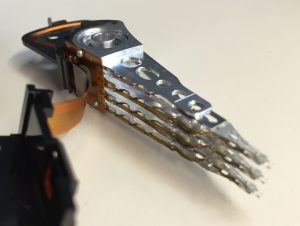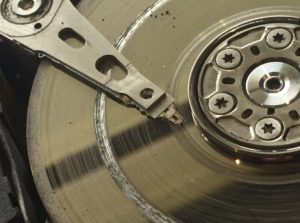 A simultaneous head crash across multiple drives in a RAID 10 array is a severe data loss scenario that requires immediate treatment in a professional data recovery laboratory.
A simultaneous head crash across multiple drives in a RAID 10 array is a severe data loss scenario that requires immediate treatment in a professional data recovery laboratory.
In fact, multiple head crashes require a laboratory diagnosis — head crashes can share symptoms with other types of hard drive failures, including firmware corruption and electronics (PCB) issues.
While RAID 10 is designed for high performance and redundancy, redundancy is not a replacement for backup. In this article, we’ll explain how these multi-drive failures happen on RAID 10 systems and how to take immediate action to maximize your chances of a successful data recovery.
Datarecovery.com provides-risk free evaluations and a comprehensive no data, no charge guarantee. If you’ve lost data from a RAID 10, call 1-800-237-4200 or submit a ticket online.
A Quick Primer on RAID 10
To understand the failure, you first need to understand the architecture. RAID 10 (also known as RAID 1+0) is a nested RAID level that combines disk mirroring and disk striping to protect data.
Here’s what each of those terms means in practice:
- Mirroring (RAID 1): Two or more drives are set up as identical pairs. Everything written to one drive is simultaneously written to its mirror.
- Striping (RAID 0): Data is split and written across multiple drives to increase performance.
RAID 10 is a stripe of mirrors, which means that it takes multiple mirrored sets and stripes data across them. This configuration provides excellent read/write speeds and strong redundancy.
Typically, you can lose one drive from each mirrored pair without experiencing any data loss. However, multiple hard drive failures — while rare — are always a possibility.
Hard Drive Head Crashes
Inside every hard disk drive (HDD), read/write heads fly nanometers above spinning platters, which store your data magnetically. A head crash occurs when one of these heads makes physical contact with a platter surface.
When the head is in contact with the platter, it scrapes away the magnetic material, destroying the data stored in that location. The impact also creates microscopic debris that gets scattered across the platter surfaces. 
As the drive continues to run, this debris is dragged around by the heads, causing catastrophic rotational scoring and grinding away at the data layer across the entire platter. This is why the single most important thing you can do after a suspected head crash is to power off the drive — otherwise, you’re risking permanent data loss.
The image to the right shows a hard drive that operated for an extended period of time following a head crash. Each of those “rings” represents permanent data loss (and unfortunately, we weren’t able to restore usable data to our customer in that case).
Why Would Multiple Hard Drives Fail At Once?
So, how can multiple, independent drives in a RAID 10 array all suffer head crashes at the same time?
In some cases, it’s pure coincidence — but more often, it’s some sort of external event that impacts the entire system. Some common culprits:
- Physical Shock: If a server or network-attached storage (NAS) device is dropped, knocked over, or subjected to severe vibration, the force can cause the read/write heads in all the drives to crash against the platters.
- Sudden Power Loss or Surge: A major power event, such as a lightning strike or a faulty power supply unit (PSU), can send an irregular voltage to the drives. That can cause the heads to park improperly or crash onto the platters as they lose power, scrambling the electronics that control head movement.
- The “Bad Batch” Problem: Drives used in a RAID array are often purchased at the same time and come from the same manufacturing lot. This means they share identical components and have been subjected to the same amount of use. It’s not uncommon for them to develop the same mechanical weaknesses and fail within a very short period of each other, particularly after a single drive failure puts additional stress on the other drives.
That last scenario is probably the most common: One drive fails, the array goes into a degraded state, and the increased stress on the remaining drives causes another, already-weak drive to crash during the rebuild attempt.
Failed RAID 10 Array: An Action Plan for Data Recovery
If you suspect your RAID 10 has suffered a multi-drive physical failure, your immediate actions matter. We recommend taking these steps:
- Power down the system immediately. Continuing to run the array will cause permanent data loss. Do not power it back on for any reason.
- Don’t attempt a rebuild. A RAID rebuild is an intensive process that reads from the good drives to write to a new one. Attempting this with physically damaged drives won’t work, and it will cause additional platter damage.
- Don’t run data recovery software. Software tools are designed for logical data loss scenarios like accidental deletion or formatting, not for severe physical failure.
- Label the drives. Carefully label each drive with its position in the RAID enclosure (e.g., “Bay 1,” “Bay 2”). Make a list of any symptoms that preceded the failure, including unusual noises, error messages, and operation issues.
- Contact a reputable data recovery provider. Physical hard drive failures require a certified cleanroom, specialized tools to work with damaged platters, and a deep understanding of RAID 10 architecture. Unfortunately, there is no DIY solution for a simultaneous head crash.
The Professional Data Recovery Process for RAID 10
When we receive a RAID case with multiple hard drive failures, our engineers disassemble each failed drive in a certified cleanroom environment to prevent further contamination. Our primary goal is to create a 1-to-1 sector clone of every recoverable platter surface from each drive in the array. When we have a complete set of clones, we use purpose-built systems to virtually reconstruct the RAID 10 and extract the user’s data.
Datarecovery.com is uniquely equipped to handle catastrophic RAID failures:
- Real, Full-Service Laboratories: We operate fully-equipped labs in each of our locations. Your media is handled by our expert engineers on-site from start to finish, ensuring a secure chain of custody.
- Decades of Specialized RAID Experience: We have successfully recovered data from every RAID level and configuration since the technology’s inception. Our engineers are experts with all controller cards (common options include Broadcom/LSI, Adaptec, Intel) and systems (Dell, HP, Synology, QNAP, and more).
- An Extensive Donor Parts Inventory: With an inventory of tens of thousands of donor drives, we can quickly find the matching components needed for physical repairs.
- Proprietary Technology: We invest heavily in research and development, creating our own imaging hardware and software tools to overcome challenges that prevent full recoveries.
If you’re facing data loss from a failed RAID 10 array, we have the experience and technology to help. Contact Datarecovery.com at 1-800-237-4200 for a free evaluation or submit your case online.




